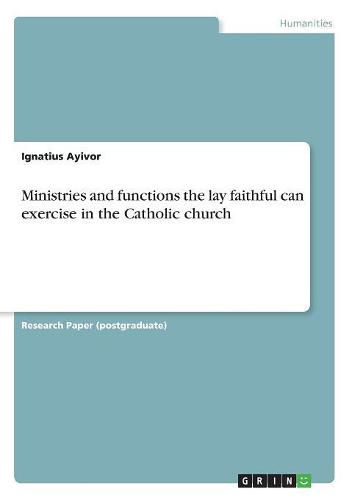Readings Newsletter
Become a Readings Member to make your shopping experience even easier.
Sign in or sign up for free!
You’re not far away from qualifying for FREE standard shipping within Australia
You’ve qualified for FREE standard shipping within Australia
The cart is loading…






Research Paper (postgraduate) from the year 2010 in the subject Theology - Practical Theology, grade: 1.5, language: English, abstract: In the early Church, the question of who was a lay person or who was not a cleric was not much of a concern since the Church acted as one body. Any action taken by the part of the Church members involved the action of the whole Church. However, this does not mean that in the nascent Church all the members formed a kind of amorphous body in which there were no distinctions. Since the genesis of the Church, there has been a distinction among her members. There are two different categories of Christ’s faithful. There are the clerics and the lay faithful. The clerics are the ordained members and the lay faithful are the non-ordained members. The two groups are not regarded as different ontologically. One group is not more important or more a member of the Church than the other. Both categories have rights and obligations in the Church. All who are baptized or are received into the Church are regarded as Christ’s faithful. The term Christ’s faithful applies to all baptized Christians regardless of their state or rank in the Church. As one is baptized or received into the Church, he or she gains membership by the virtue of the baptism that is recognized as sacramental. According to c. 228 of the 1983 Code of Canon Law lay people who are qualified and suitable can be admitted to ecclesiastical offices and functions by the sacred pastors. This paves a way for the active lay involvement in the life and work of the Church. However, there are limits to lay ministries. These limits need to be observed so that there will be harmony and understanding among all those who are involved in ministries in the Church. Observance and respect of the limits to one’s ministry will remove the situations that can cause conflict between lay persons who are admitted to exercise offices and functions in the Church, and the clergy.
$9.00 standard shipping within Australia
FREE standard shipping within Australia for orders over $100.00
Express & International shipping calculated at checkout
Research Paper (postgraduate) from the year 2010 in the subject Theology - Practical Theology, grade: 1.5, language: English, abstract: In the early Church, the question of who was a lay person or who was not a cleric was not much of a concern since the Church acted as one body. Any action taken by the part of the Church members involved the action of the whole Church. However, this does not mean that in the nascent Church all the members formed a kind of amorphous body in which there were no distinctions. Since the genesis of the Church, there has been a distinction among her members. There are two different categories of Christ’s faithful. There are the clerics and the lay faithful. The clerics are the ordained members and the lay faithful are the non-ordained members. The two groups are not regarded as different ontologically. One group is not more important or more a member of the Church than the other. Both categories have rights and obligations in the Church. All who are baptized or are received into the Church are regarded as Christ’s faithful. The term Christ’s faithful applies to all baptized Christians regardless of their state or rank in the Church. As one is baptized or received into the Church, he or she gains membership by the virtue of the baptism that is recognized as sacramental. According to c. 228 of the 1983 Code of Canon Law lay people who are qualified and suitable can be admitted to ecclesiastical offices and functions by the sacred pastors. This paves a way for the active lay involvement in the life and work of the Church. However, there are limits to lay ministries. These limits need to be observed so that there will be harmony and understanding among all those who are involved in ministries in the Church. Observance and respect of the limits to one’s ministry will remove the situations that can cause conflict between lay persons who are admitted to exercise offices and functions in the Church, and the clergy.